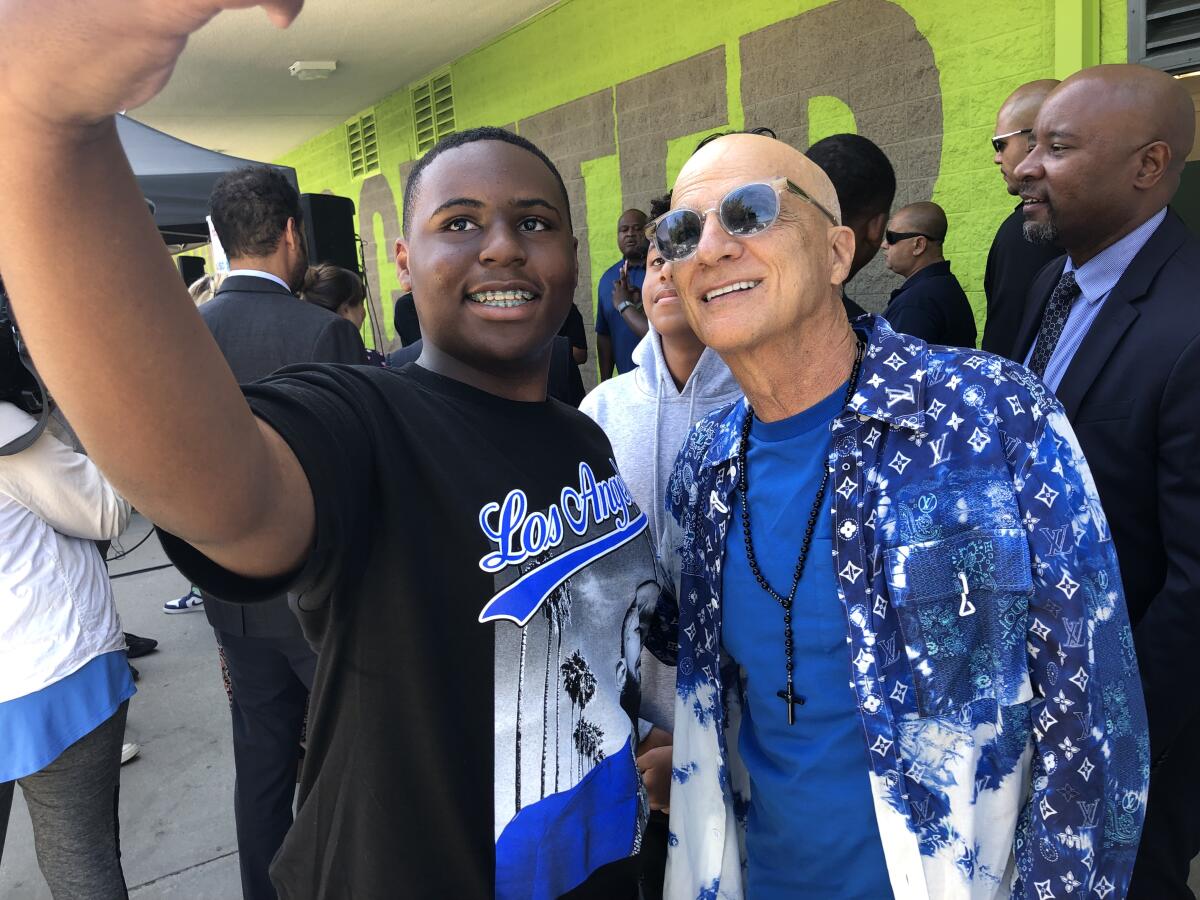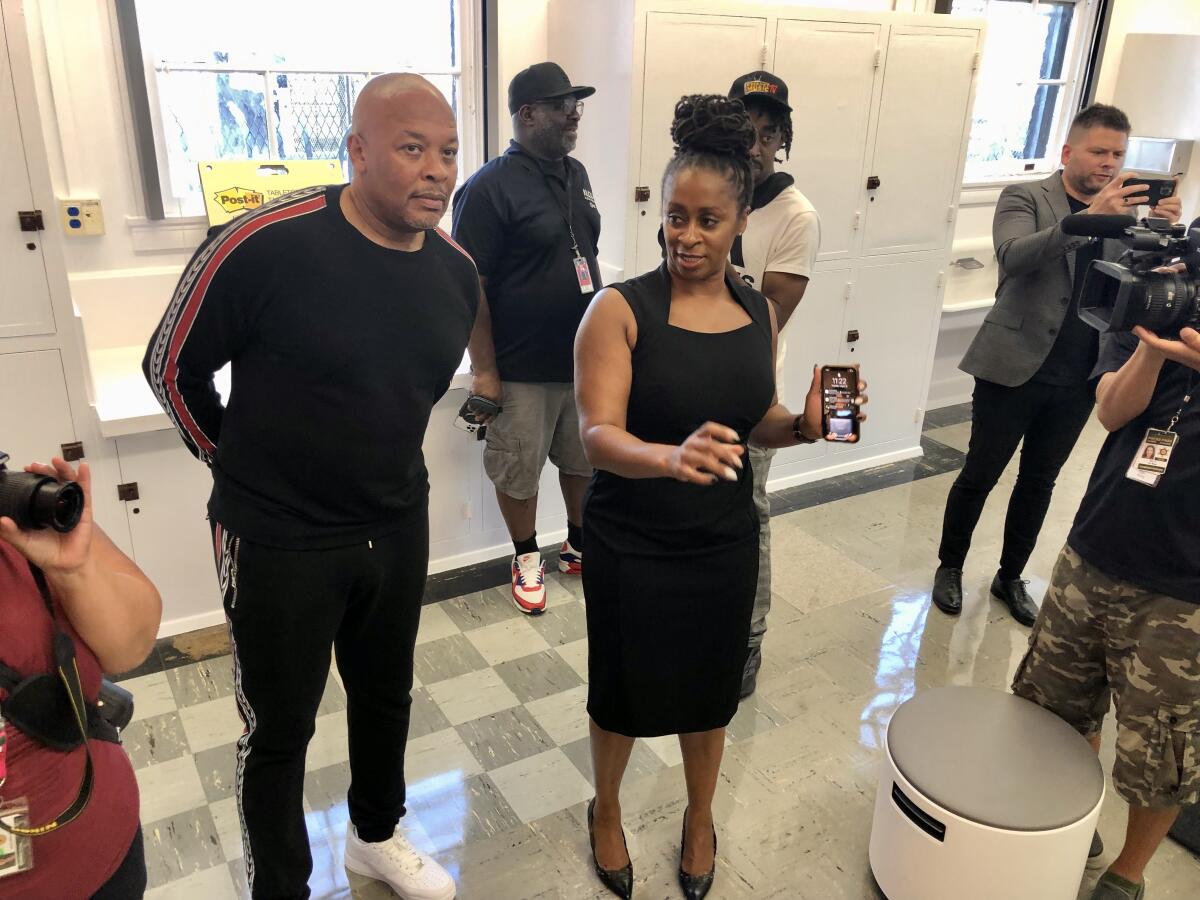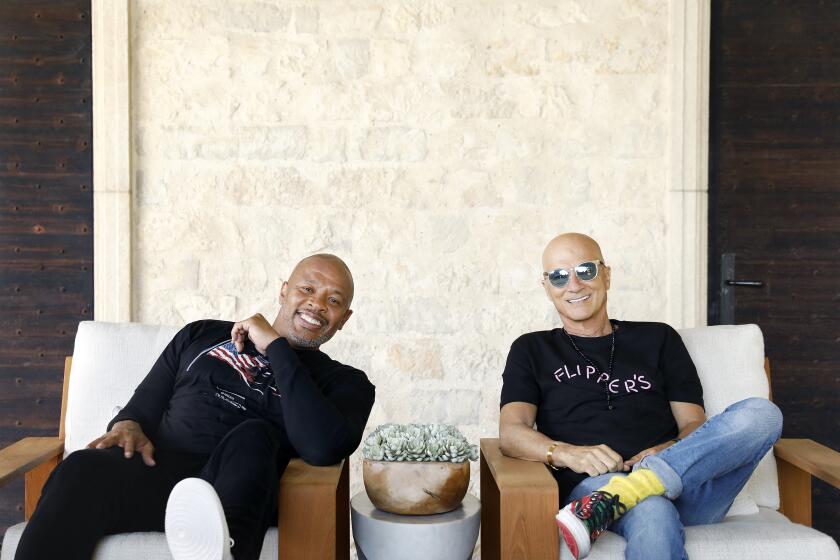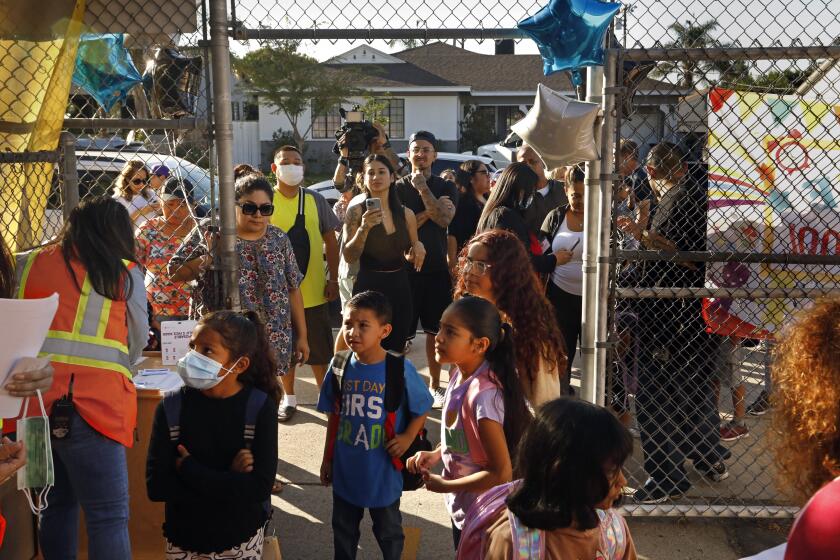The Dr. Dre, Jimmy Iovine high school gets down to business, just not the music business

- Share via
When it comes to machinery that spins, a turntable — not a washing machine — seems a more fitting association with rap artist Dr. Dre.
But for students from the Los Angeles school district’s new high school, the brainchild of Andre “Dr. Dre” Young and fellow music industry mogul Jimmy Iovine, the lowly washing machine became the star of a lesson about water conservation. The students conceptualized and built a prototype, made out of cardboard with a tub that actually did spin, with the potential to recycle gray water for irrigation.
That kind of thinking is at the core of the Iovine and Young Center Integrated Design, Technology, and Entrepreneurship Magnet, a high school based at Audubon Middle School in the Leimert Park neighborhood. The star power of the school’s namesakes has helped to draw first-year and sophomore students, and educators hope the school will serve as a bright spot for reversing declining enrollment by engaging young minds in cool and cutting edge ways.
Sean Roberts, a ninth-grader, said the chance to meet Dr. Dre was a selling point. He wants to become a pharmaceutical scientist.
He chose the school because “I felt like the things that they taught and that the school is trying to do will help me for my career. And the more I researched about it, it sounded really fun.”
“And,” he added, “it would be nice to meet a celebrity like Dr. Dre.”
Dr. Dre and Iovine did not disappoint, making time to have their pictures taken with students at an official grand opening ceremony Thursday during the first week of school.
When the two launched the project with school board approval, Dr. Dre said he wanted to bring in “the younger me” and create a campus where students would be excited about learning. What’s emerged is neither a music school nor even an arts school. It’s not even a training ground for the music industry — although some students could end up in that field.
It‘s a place the founders hope can fill a void they saw in the business world — when they ran a record company and later the company that made Beats headphones.
The new magnet high school will be based at Audubon Middle School. The campus in Leimert Park has experienced a sharp enrollment decline, as have nearby high schools.
“We found that in hiring people, they either had one of three or four different disciplines,” Iovine said, either as engineers, designers, creative talent or businesspeople. “They didn’t know how to work together. They didn’t know how to speak together. ... And it’s very, very important that in today’s workplace that people do understand the other disciplines and are familiar with the other disciplines.”
At the high school, students will be challenged with problems that will require the joint application of skills that are taught separately in a traditional education.
Principal Akilah Calhoun purposefully chose teachers with multiple skills: “My art teacher has an English credential. And she also has a career technical education credential in arts, media and entertainment.
“We’re talking about opportunities for students to experience computer science alongside mathematics; ethnic studies alongside entrepreneurship,” Calhoun said. “Students work in teams throughout the day. We are now no longer isolating the content areas.”

To develop the curriculum, the faculty worked with trainers affiliated with the USC Iovine and Young Academy, the already established college-level version of the high school. Iovine and Dr. Dre hope eventually to push this approach down to the elementary level.
While Dr. Dre did not speak during the Thursday event, he made it clear in an earlier interview that he wants the school to create the kind of excitement for students that was lacking in his experience in local public schools.
So far so good, said ninth-grader Kylie Bailey.
“We aren’t just sitting in class taking notes and heading home to do homework,” Kylie said. “We’re now starting to think of real-life situations, and how we can apply what we learned into these situations. It’s only been four days and I’ve already learned how to improve my speaking skills. I’ve also learned how stereotypes affect us and our diet and our identity in ethnic [studies] class.”
These ideas are not all new. Much of this approach is reflected in a new wave of career and technical education that is changing middle and high schools — to make school more relevant. It doesn’t hurt to have two celebrities who say they are willing to spend whatever it takes to develop a best-in-class program, which includes about $2.5 million in facilities upgrades so far.
Supt. Carvalho pledges ‘year of acceleration’ to offset the learning crisis caused by the pandemic.
Zion Adams, another ninth-grader, is a rapper and Dr. Dre’s background was meaningful to him: “I felt like it’d be a good opportunity.” He was impressed by the USC facilities he saw during the school’s summer program, although they have not yet been replicated at the Audubon campus.
Zion previously attended a privately managed charter school before enrolling this fall in an L.A. Unified program.
Calhoun, the principal, estimates that 30% to 40% of students came from charters or were learning online last year in response to the pandemic. The school is near its target of 60 ninth-graders but has had difficulty recruiting 10th-graders — it can be challenging to get high schoolers to switch schools. The program will gradually build out to a grade nine through 12 high school.
Because the new school is a magnet program, the L.A. school system provides transportation, and students come from as far away as the San Fernando Valley. Most are Black.
Officials hope the school can help offset some of the rapidly declining L.A. Unified enrollment, although it’s also drawing from other district-run schools in the area, which already struggle with low enrollment.
L.A. schools Supt. Alberto Carvalho characterized the school Thursday as among an improving brand of innovative choices that will attract students and serve them well.
The dean of the USC academy, Thanassis Rikakis, said the goal is to “bring learning innovation to education” and “create more inclusive, equitable and accessible educational experiences and environments.”
More to Read
Sign up for Essential California
The most important California stories and recommendations in your inbox every morning.
You may occasionally receive promotional content from the Los Angeles Times.













